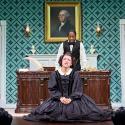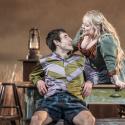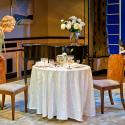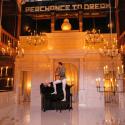Rona Munro’s trilogy of plays about Scotland’s Stuart kings premiered at the Edinburgh Festival when Scottish independence was, for many, still a cherished possibility; it transfers to London – within a clarion call of Westminster – just as the promise has been dashed. As timely as the National’s recent Great Britain, the trilogy is more than merely opportune, resonating with the anger and frustration of centuries.
These boisterous, bracing, subtly thought-provoking and hugely entertaining plays are also a rarity in offering a new history cycle to accompany those of Shakespeare. While the period covered is virtually concurrent with Shakespeare’s 16th-century cycles, the gaze is northward, upon an unfamiliar trio of kings, and marked by a contemporary vernacular that makes the work refreshingly accessible.
That said, writer Rona Munro shares with Shakespeare a sense of history informed by an appreciation of human frailty and foible, nobility and laughter.
For this production two high banks of scaffold seating have been constructed behind the Olivier stage, a throne placed high between them. Actors regularly clamber up the structure and sit among the audience, using their numbers to flesh out the privy council, or other such gatherings. Below them, a giant sword – and I mean giant – pierces the stage floor, the only permanent feature onstage. Tables, chairs and other accoutrements are wheeled in as needed, but the minimalism heightens the sense of what’s important in this world of political manoeuvring, blood feuds, treachery and love – the throne, the sword and the bed.
James I: The Key Will Keep The Lock concerns the return to Scotland of its king (James McArdle, pictured below), after 18 years of imprisonment in England – freed by Henry V as a way of persuading the Scots to end their troublesome alliance with the French.
Munro doesn’t waste any time establishing certain characteristics of her cycle. As the play opens, Henry (Jamie Sives) chides his captive as “the king nobody wants”, belittling him in front of a group of fellow Scots, mocking him for his lack of royal wherewithal. A crass bully far removed from Shakespeare’s heroic warrior king, this Henry will haunt James in the years to come, the Scot’s determination to prove himself a better man than his nemesis reflecting his country’s own obsession.
Henry’s principal advice seems to have been adopted by monarchs through the ages: "You have to fuck women you don't know and execute their relatives". In this opening scene the playwright launches straight into dialogue that is ripe and rude, comic and colloquial. "In your fucking dreams, Henry boy", cry other Scottish prisoners in the same scene, their raucous disregard for their captor foreshadowing their later rebellion against their own king.
 And so James returns with a new queen, Joan (Stephanie Hyam), a pampered English noblewoman petrified by the cold and dark and the tiny spaces of Scottish castles, not to mention the local custom for men to crowd around the marriage bed as though watching a sporting event.
And so James returns with a new queen, Joan (Stephanie Hyam), a pampered English noblewoman petrified by the cold and dark and the tiny spaces of Scottish castles, not to mention the local custom for men to crowd around the marriage bed as though watching a sporting event.
For his part, James at first wins over the nobles who have been making hay in his absence, with a passionate speech riling against England, which has “pursued our wealth and bled our wealth, and will do for centuries to come”. But both honeymoons are short-lived, and the pressures upon the king will transform his character from poetry-writing idealist to cold-hearted pragmatist.
James II: Day of the Innocents focuses on a young king (Andrew Rothney) plagued by nightmares from childhood and now in thrall to ambitious noblemen jostling for control of the country in his name; the puppet used to represent his childhood is apt for someone who is now a puppet king. A new French wife, Mary (Hyam again), gives James the courage to exert his authority, only for his best friend’s jealousy to signal another crisis.
In contrast, the cultured yet petulant and self-indulgent James III of The True Mirror (Sives, enjoying himself as both English and Scottish kings, each of them rascals) is so sure of his own mind, and has so committed a sense of entitlement that he leaves his country to rot. The head of the privy council turns to James’s Danish queen Margaret (Sofie Gråbøl, pictured below with Sives) for help, though her own relations with her husband are strained to breaking point.
 The individual plays stand alone well enough, with the possible exception of James II, which occasionally feels schematic and forced. They benefit hugely from being seen within the trilogy: a collective study of power, hubris and self-determination, with a recurring act of God – the plague – to level the playing field once in a while.
The individual plays stand alone well enough, with the possible exception of James II, which occasionally feels schematic and forced. They benefit hugely from being seen within the trilogy: a collective study of power, hubris and self-determination, with a recurring act of God – the plague – to level the playing field once in a while.
Common themes spread across the seven hours: kings struggling to find their voice, queens with a dramatic influence on their husbands, for good and ill, a strain of Scottish psyche that resists any authority, whether from England or within, and of warm-hearted yet querulous folk at times intent on self-destruction. “I come from a reasonable, rational people," riles Margaret to the court. "You’ve got fuck all except attitude.”
That’s a bit harsh, but perhaps Munro is suggesting a people as conflicted about their own place in the world in the 16th century as the voting in the referendum suggests they still are today. The eponymous mirror of the final play (a novelty for the period) is a gift from the king to his wife, in which numerous characters confront images of themselves they hadn’t seen – older, younger, prettier, uglier than they had imagined; the effect for some is empowering, for others disabling, while the mirror held up to Scotland by the plays themselves may suggest different things to different Scots in the audience.
For the rest of us, the experience is a feast. Laurie Sansom, the artistic director of the National Theatre of Scotland, has brought down a production of gusto and clear-sightedness, huge heart and infectious good humour – featuring masterful choreography (not just the customary battle scene, but a brilliant soccer match) and magical sprinklings of music and song. Designer Jon Bausor’s nicely functional set is matched by some fabulous costume design, not least for Gråbøl.
 The leads present three very different kings – McArdle’s hesitant hero, who could have stepped straight out of a Ken Loach movie, Rothney’s sensitive young man, Sives’s rock 'n' roll dandy – matched by three very different queens. Gråbøl, something of a royal in her native Denmark thanks to The Killing, is marvellous as the hard-working royal behind the throne whose exasperation for both husband and adopted country is accompanied by love, her integrity by palpable intelligence. But I also got a huge kick out of Hyam’s dual roles as the pathetic Queen Joan and feisty Queen Mary, her comic timing and diction epitomising the contemporary feel of the writing.
The leads present three very different kings – McArdle’s hesitant hero, who could have stepped straight out of a Ken Loach movie, Rothney’s sensitive young man, Sives’s rock 'n' roll dandy – matched by three very different queens. Gråbøl, something of a royal in her native Denmark thanks to The Killing, is marvellous as the hard-working royal behind the throne whose exasperation for both husband and adopted country is accompanied by love, her integrity by palpable intelligence. But I also got a huge kick out of Hyam’s dual roles as the pathetic Queen Joan and feisty Queen Mary, her comic timing and diction epitomising the contemporary feel of the writing.
Other stand-outs in the multi-tasking ensemble include Gordon Kennedy (pictured above, with McArdle) with three skillfully delineated exercises in peripheral power-wielding, Peter Forbes as a convincingly obsequious nobleman on the make, and Blythe Duff, who offers this Scottish tragedy her own Lady Macbeth.















Add comment